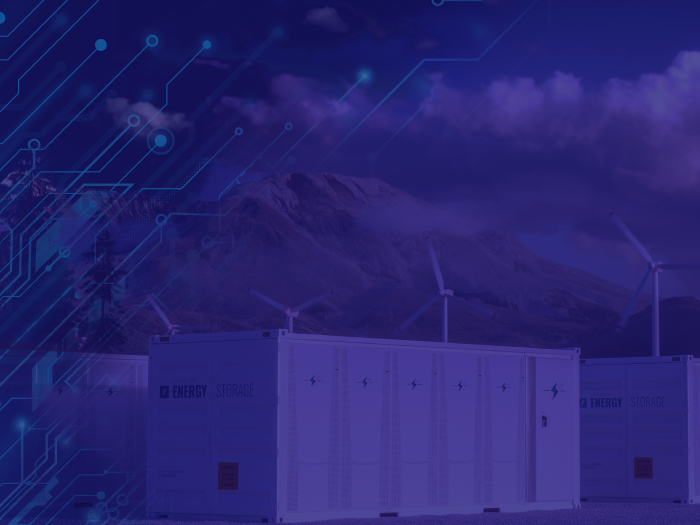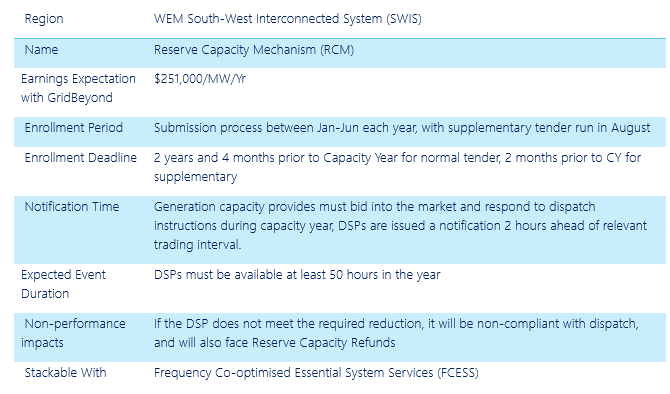News
better business decisions
Posted 10 months ago | 4 minute read

Reserve Capacity Mechanism…explained
The Reserve Capacity Mechanism (RCM) in Western Australia (WA) ensures that enough capacity is available to meet peak electricity demand. It allows Capacity Providers to secure payments by committing capacity to the system.
Businesses with flexible load can participate in the programme and earn up to $251k/MW/year in revenues.
But what is the programme and how does it work?
What is the RCM?
The primary role of the Reserve Capacity Mechanism (RCM) is to meet reliability requirements by ensuring sufficient capacity (or Reserve Capacity) is available to meet system demand and maintain electricity system requirements during peak demand events. The RCM contributes towards the costs of providing this capacity.

The RCM operates on a three-year cycle. In the first year, AEMO assigns Capacity Credits to suppliers of registered capacity who are expected to be available to provide supply to meet the expected peak system demand two years in the future.
Eligible suppliers are issued Capacity Credits for their facilities and must make that capacity available to the market during the relevant Capacity Year (that is, from 1 October (Year 3) to 30 September (Year 4) of the relevant Reserve Capacity Cycle.
Non-Dispatchable loads can be classified as Demand Side Programmes for participation in RCM, and are classified as Availability Class 2 (not always available). Availability Class 1 is the primary class and only when these resources are exhausted will AEMO call on Availability Class 2 facilities to respond.
DSPs are awarded capacity based on the amount of load they can curtail or able to curtail via contractual arrangements where they do not own, operate, or control the Non-Dispatchable Loads which their facility is associated with. Capacity is awarded based on the DSP’s ability to curtail load relative to its Relevant Demand, which is indicative of the consumption of its Associated Loads during Peak Trading Intervals.
Dispatch signals to DSPs are sent 2 hours ahead of relevant dispatch interval.
Benefits of the WA RCM:
For C&I businesses in Western Australia, involvement in the Reserve Capacity Mechanism offers numerous advantages, from generating new revenue streams and reducing energy costs to enhancing sustainability and innovation. As the energy market continues to evolve, participation in programs like the RCM provides forward-thinking businesses with the tools to optimise their energy use and contribute to a stable and resilient electricity grid.
Benefits include:
- Revenue generation: Businesses can earn additional revenue by providing reserve capacity. This can be achieved through demand-side management (reducing electricity use during peak times) or investing in on-site generation like solar panels or battery storage.
- Energy cost reduction: Participation in the RCM can reduce energy costs by optimising energy consumption, particularly by reducing usage during high-demand periods. Businesses can leverage their flexibility to manage energy more efficiently.
- Enhanced sustainability: By contributing to the stability of the electricity grid, businesses can enhance their sustainability profiles. This supports corporate social responsibility (CSR) objectives, reducing their carbon footprint, and aligning with broader environmental goals.
- Increased energy security: Participating in the RCM ensures a reliable electricity supply, reducing the risks associated with grid instability or power outages. For energy-intensive industries, this added security is crucial to maintaining operations without disruption.
- Competitive advantage: C&I businesses that actively manage their energy consumption and participate in RCM stand out as leaders in energy efficiency and sustainability, improving brand image and competitive positioning.
- Long-term contracts: The RCM offers long-term revenue streams through capacity credits, providing businesses with a steady and predictable income. This is especially beneficial for companies that invest in energy infrastructure like renewable energy sources or storage solutions.
- Support for innovation: Participation encourages businesses to innovate in energy management. Implementing advanced technologies such as smart grids, energy management systems, and IoT can optimise performance and create additional opportunities for cost savings.
- Contribution to grid reliability: By participating in the RCM, businesses contribute to the overall reliability and resilience of the electricity grid. This not only benefits the wider community but also ensures their operations are less vulnerable to blackouts or supply disruptions.

Western Australia Demand Response
Demand Response (DR) offers a cost-free opportunity for businesses to earn money by reducing electricity demand during peak times or grid stress. Following the market reform in Western Australia in October 2023, participants can now provide energy and frequency control services, capitalising on this dynamic landscape.
Learn more





